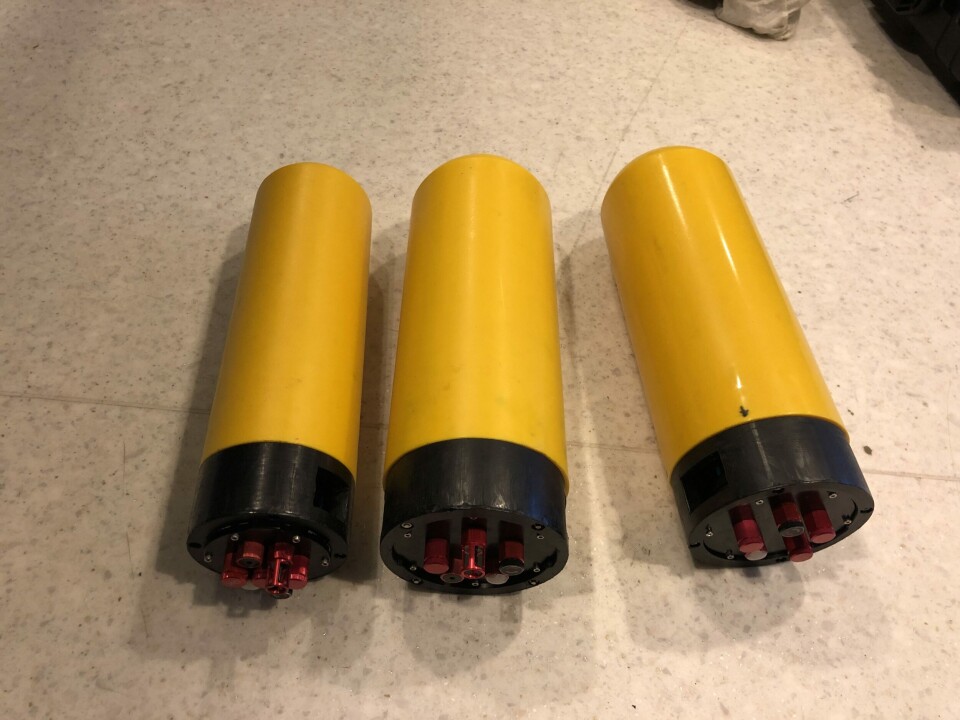
Study: crowding is harder on fish than Hydrolicer
Researchers using an electronic “sensor fish” to measure any damage Hydrolicer delousing may cause farmed salmon believe that corralling the fish into a small area before treatment is likely to put more mechanical stress on them than the delousing process itself.
The Hydrolicer project is being run by independent Norwegian research institute, Sintef, which is also intending to evaluate other mechanical delousing methods.
Researchers have been using knowledge gained from a “sensor fish” developed by another Sintef project, Kvalisys. The sensor fish is a half-metre long cartridge-like object containing a small computer with electronics that can measure the mechanical forces a fish is subjected to.

Pressure and acceleration
“Think of a large pipe, where the fish is pumped through from an inlet in a cage to the outlet of another,” said Sintef cybernetics expert Walter Caharija. “The sensor fish itself contains electronics that detect temperature, pressure and acceleration. And not least how it responds to the time in the pump systems.”
“We have gone from having no knowledge of what the fish is exposed to with regard to mechanical strain, to having several different measurements for what stresses are involved,” says Torfinn Solvang, researcher and project manager for the Hydrolicer project, in an article on Sintef’s website.
What the researchers found was that the physical loads on the fish before delousing were likely to be more stressful than the actual delousing process.

An hour’s wait
“The fish must be moved into the delousing chamber itself. This happens by means of a pump. In order to get the fish into the pump, they must be gathered together, so that the pump actually gets hold of fish and not just water. This is a process that can take an hour or more, while the actual delousing takes less than half a minute,” Solvang explains.
The researchers also found a difference between pumping systems: so-called ejector pumping that takes place by means of high water pressure applied fish less physical influence on the fish (measured in the form of acceleration) than so-called impeller pumping. The latter pumping method is based on moving the fish by means of a mechanical paddle in the water flow.
Sintef researcher Ulf Gøran Erikson has seen the development in the industry close up for several decades and has also collaborated extensively with veterinarians in several of his research projects.
He says an increasing amount of research suggests that fish may also feel pain, but so far it has been difficult to measure this.

‘Vegetables to soda bottles’
“Everything from vegetables to soda bottles have previously been sent through the pump systems as testing,” explains Eriksen, who also works in the Hydrolicer project.
But neither vegetables nor the sensor fish have the will that a fish has. In addition, it is a skilled swimmer which can position itself optimally.
“It will be interesting to see if we can find new methods to look at how the fish actually experience the various treatments,” he adds.
Erikson emphasises that they have not evaluated all the delousing methods that are in use, and that they cannot respond to all the challenges associated with fish welfare using the sensor fish.
“We are talking about mechanical strain. The sensor fish cannot tell us anything about the fish’s stress level. We are unable to measure that with our electronics. At any rate not yet,” he says.
Erikson and Solvang reveal that new projects have just been initiated to find more answers to the fish’s physiology.
“The next is to measure the heart rhythm of the fish, then we can say more surely how the fish really responds to delousing using the various methods,” concludes Erikson.























































